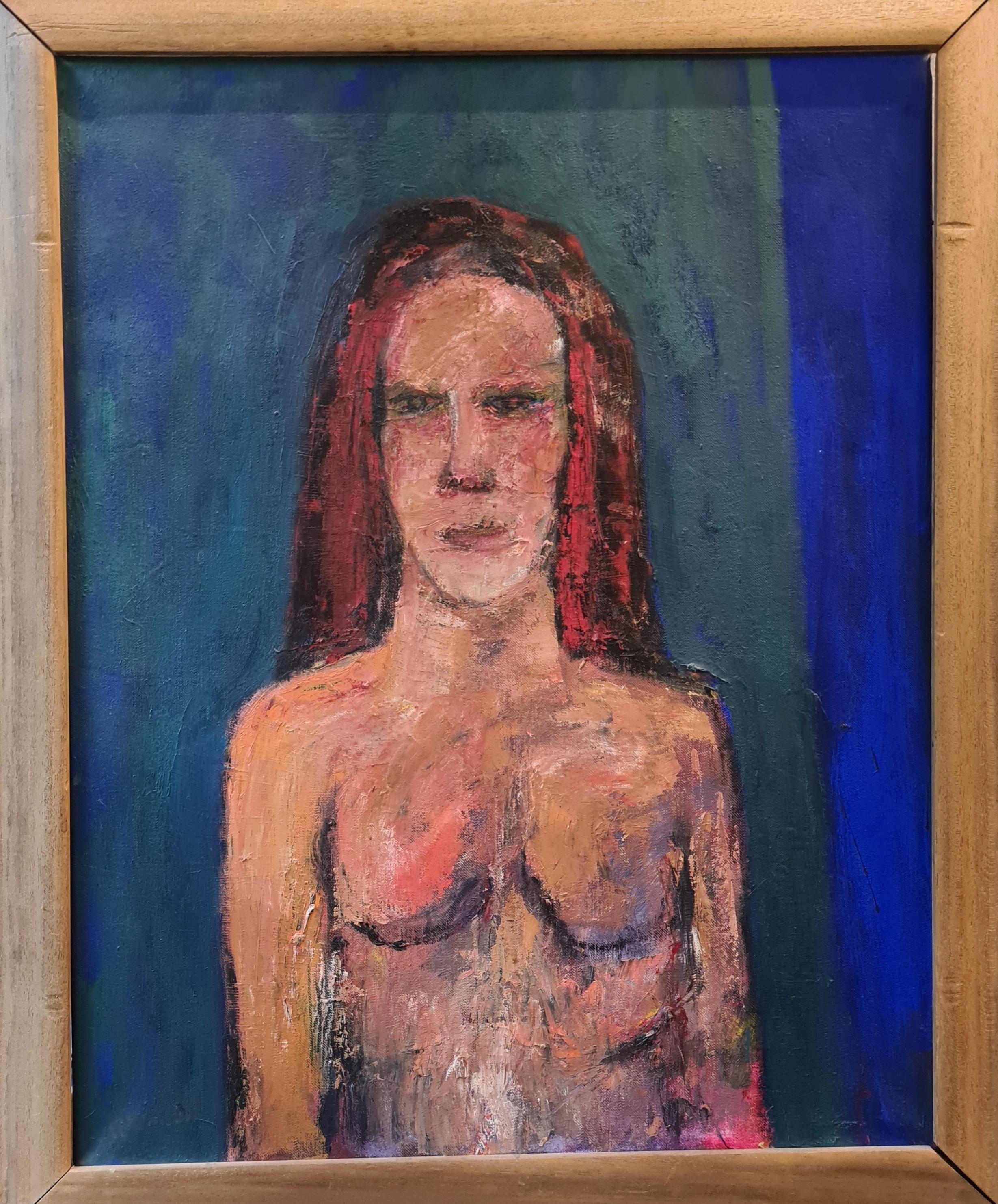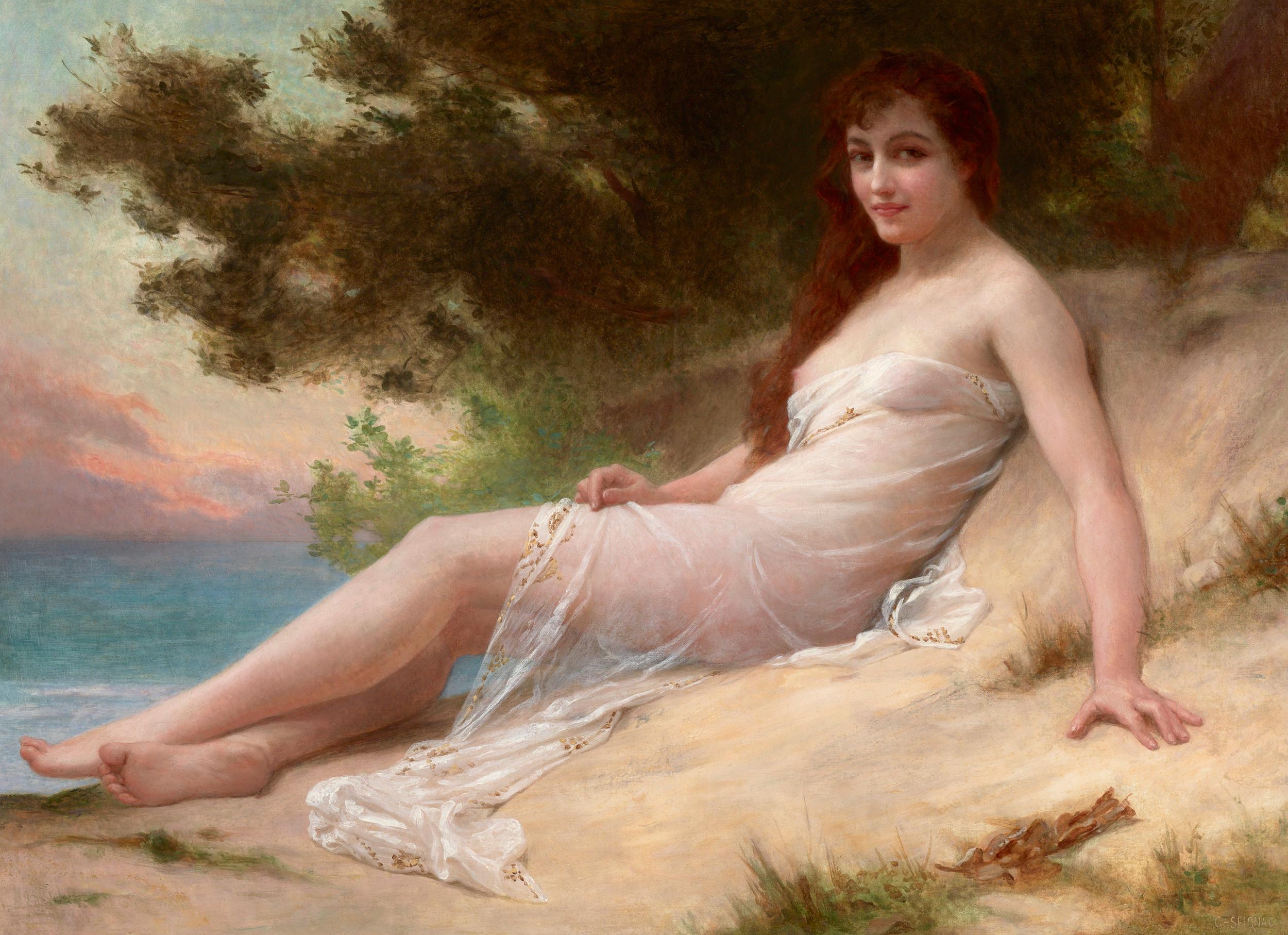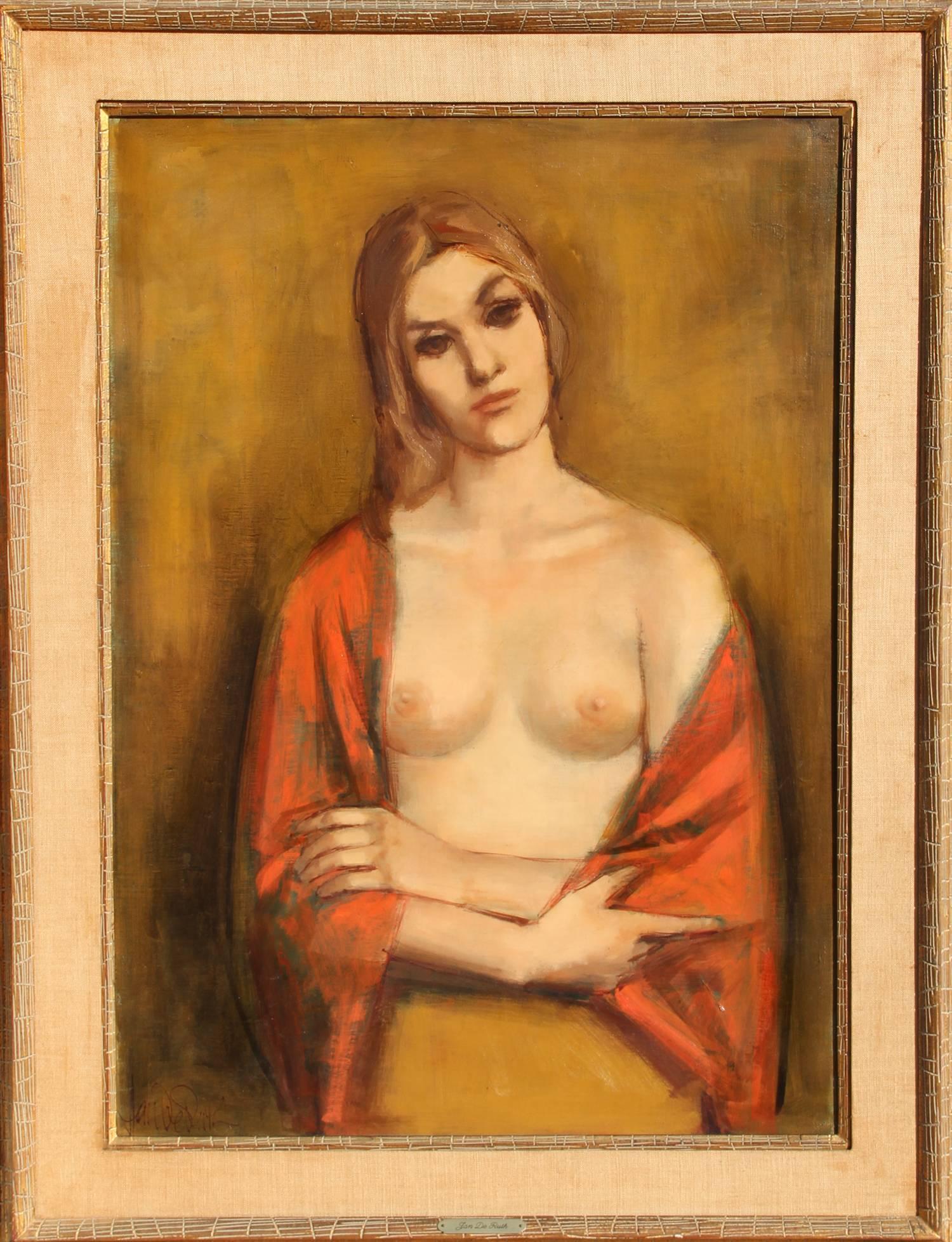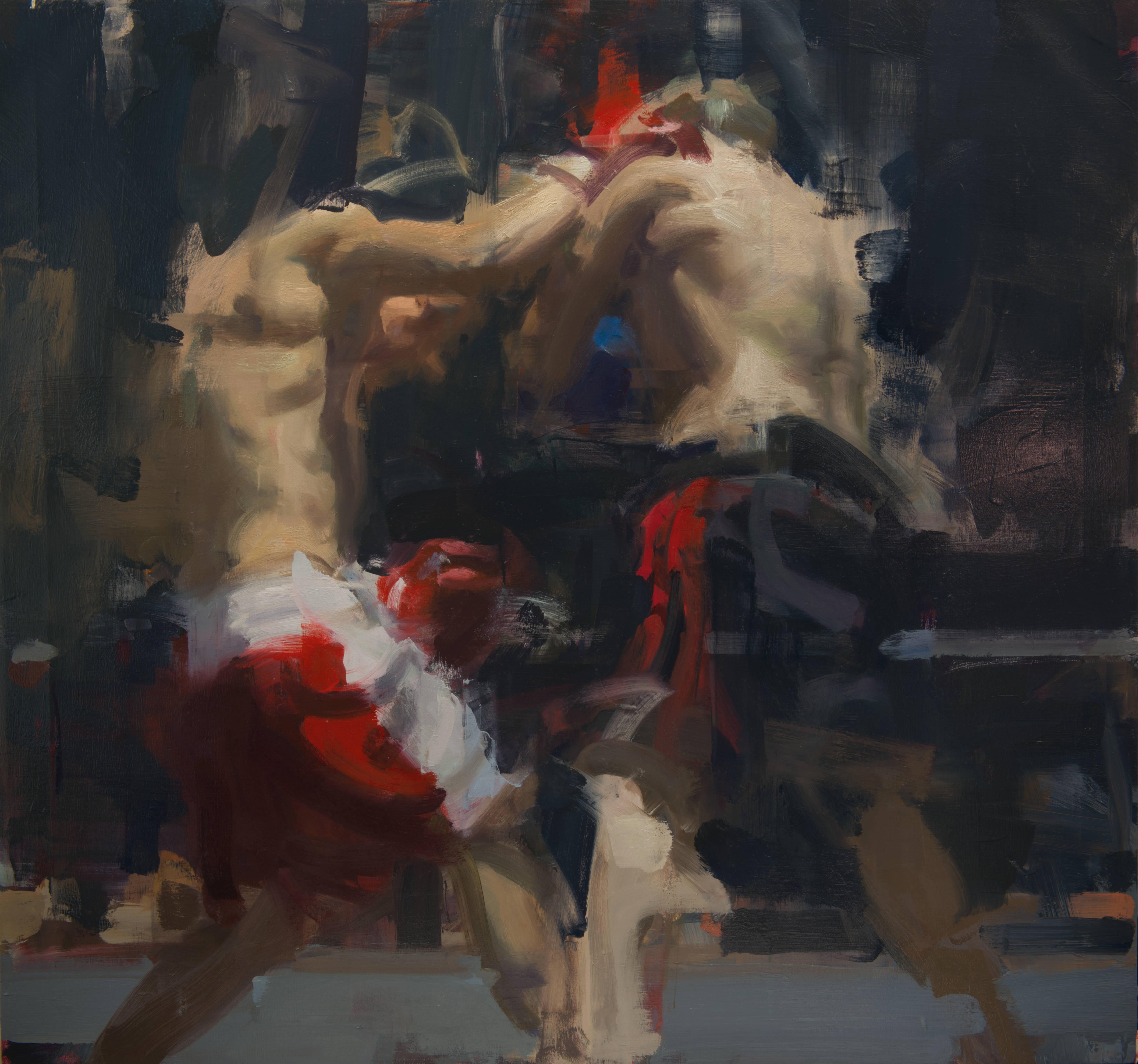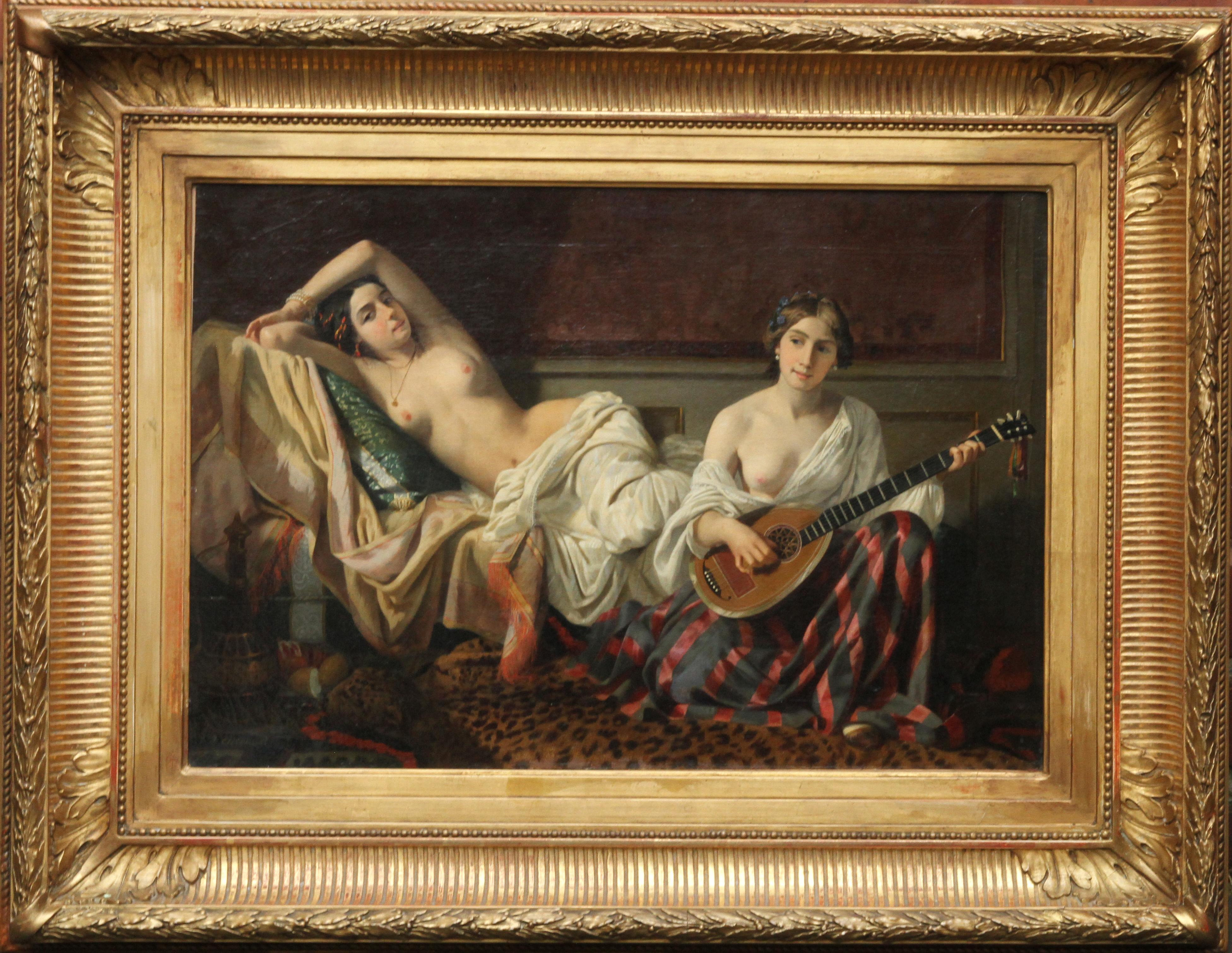Items Similar to Model undressing
Want more images or videos?
Request additional images or videos from the seller
1 of 12
Julius ExnerModel undressing1842
1842
About the Item
Julius EXNER
(Copenhagen, 1825 - Copenhagen, 1910)
Model stripping
Oil on canvas
H. 122 cm; L. 74 cm
Signed and dated 1842 lower right
Exhibition: most likely Charlottenborg Salon of 1845, under number 110, titled Modelfigur, awarded with a silver medal
Provenance: Emilio Fernando Bolt (c.1860 - 1944), acquired from the artist around 1900, then by descent
Our painting was produced as part of the summer sessions organized between 1839 and 1850 by Christoffer Wilhelm Eckersberg (1783-1853), the master of Danish painting of the first half of the 19th century, in his private studio-apartment on the ground floor. floor at the Royal Academy of Fine Arts in Copenhagen. The master brought together a few students there between June and September, rented one or two models for the season, which were painted from different angles, the artists (including Eckersberg himself) sitting side by side. Eckersberg used to paint a fairly small version, the pupils of the larger formats.
The work fits more generally into the legendary context of the research and reforms carried out by Eckersberg concerning the studies of nudes and in particular of female nudes, to make this exercise a genre of painting in its own right.
Following his two-year stint in Jacques-Louis David's studio in Paris in 1811, Eckersberg had been made aware of work on the nude and in particular on live models, in natural light, while in Denmark the drawings were then only made from casts of antique models or other mannequins. In 1822, when he had been a professor there since 1818, it was he who had the Royal Academy of Copenhagen authorize the study of nudes, no longer in the evening by candlelight, but in natural light; from 1833, it was still he who allowed students to work on nude female models, even if the official authorization of the Academy did not take place until 1839.
It was this same year that he instituted his summer sessions, on a private basis, to orient his painting and that of his students towards a new conception of the representation of models: even if the nude remains the real theme, it does not however, this is more than just an academic exercise. The subject is placed in a contemporary interior, with a rather sophisticated decor, and occupied with an intimate activity (it is this type of intimate vein that we will find later in Degas or Cassatt for example); thus in our painting, the young woman is supposed to take off her clothes to wash. The objective is that the viewer forgets that the master and his students are painting a model during a posing session, and that he instead has the impression of being alone with the model, but invisible, almost like a voyeur in spite of himself. Moreover, in these paintings, the model never looks towards the spectator, inducing a psychological distance with him, whereas model and artist are actually physically very close. On the other hand, it is not a question of idealized nudes either, even if Eckersberg, proof of his debt to the antique, chooses fairly classic models and poses. The sensuality is real and very present, with dreamy, even innocent, and timeless expressions (the models do not seem to have a defined age), suave and slow attitudes and movements, and especially with clothes that hide or reveal skillfully parts of the female body: upper buttocks, pronounced hips...
Made by an artist under 20, our sensual painting is probably one of the most beautiful and spectacular produced by the students of Eckersberg during these summer sessions. With a perfect balance between the firmness of an ancient statue (it recalls the Venus de Milo) and the softness of the feminine forms, highlighted by a harmonious palette, it captures the attention with many details: the almost photographic folds white clothing and brown fabric placed on the armchair, the subtle gradation of green of the wall hanging, the pink tint of the extremities (feet, hands, face) reflecting the probable embarrassment of the model despite her professionalism, the carefully combed hair and veneered according to the fashion of the time (particularly in Denmark), the very realistic rendering of the glossy fabric of the seat of the armchair, the tiny reflection of the window in the varnish of the mahogany leg of the table, the play of light and shadows on the different materials, and above all the dialogue between the sinuosity of the back of the armchair and that of the young woman's body. No wonder he received a silver medal at the Charlottenborg Salon (the equivalent of our Paris Salon des Beaux-Arts) of 1845.
Julius Exner, son of a Czech musician who emigrated to Denmark at the time of the Napoleonic wars, was trained in history painting by Lund (1777-1867) and by Eckersberg, before becoming from the 1850s the principal representative of "Danish Romanticism", with traditional and folkloric scenes of the Danish people, especially from the island of Amager. He traveled to Europe (Germany, Austria, Switzerland, Italy) at the end of the 1860s, and notably to France, where he had already sent two paintings to the Paris Universal Exhibition of 1855 (he would still exhibit at that of Paris in 1878), and made several stays in Sweden where he was received as a member of the Royal Academy of Arts in Stockholm in 1866. He held several positions in the administration of Fine Arts in Denmark.
The best-known painting from Exner's early years is the one, dated 1843, representing art students among the plaster sculptures of the Academy of Fine Arts in Copenhagen, and which will be exhibited at the Charlottenborg Salon in 1844 (it is now in the Staten Museum for Kunst in Copenhagen). But it seems that Exner had also participated in the 1842 edition with a drawing and that he obtained a silver medal there.
The date of our table presents an uncertainty that has not yet been completely resolved. According to Eckersberg's diaries, usually kept in detail, there was no summer session in 1842 (as in 1845 and 1846). On the other hand, we find the same female model with a similar attitude in several works produced by Eckersberg and his students, a priori during the 1844 session (note that this session is the last for which we know of works). We know that this session took place in August and September, without the name of the model being specified (see note 1 for the details of the models between 1839 and 1843) and we know the participating students - Julius Exner, Joël Ballin (1822- 1885), Geskel Saloman (1821-1902), and a female artist, Caroline Behrens - and related works. The small painting (34.2 x 30.2 cm) by Eckersberg is held in a private Danish collection; the master amused himself by modifying the furniture, and the work is traditionally described as from 1844; but is it because the painting bears an inscription 1844 (and in this case, our work would undoubtedly have been produced in the same year), or is it only by analogy with the painting (102 x 77 cm, private collection) by Geskel Saloman, him -even signed and dated 1844? But the signature and the date of 1844 of the painting of Saloman were affixed later, in 1898, and one can wonder if Saloman, then 77 years old, would not have made a confusion with the real year of execution of his painting? As for the version by Joël Ballin (117 x 92 cm, Loeb Danish Art Collection, USA), it bears no date or signature, and was somehow given to the artist by elimination.
In the end, despite the uncertain dates of the versions of Eckersberg and Saloman, the absence of references to a summer session in 1842 makes us think that our painting by Exner was executed in 1844. How then can this date be explained? from 1842? Perhaps Exner, on the occasion of the Charlottenborg Salon of 1845, he wanted, by dating his painting of 1842, to demonstrate a very precocious talent by making believe that he had been able to produce a small masterpiece only 17? Or, as we could speculate for the version of Saloman, did he affix this date with mistake in his old years, for example when he gave his painting to Fernando Bolt?
Fernando Bolt's family had emigrated to South America around the middle of the 19th century, and he himself, a pastry chef by trade, was born in Peru, hence the Hispanic sounding of his first name. He returned regularly to Denmark, and it was in Copenhagen that his son Niels Peter (1886-1955) was born, who was a painter of landscapes, still lifes, portraits, inspired by Impressionism. It was during one of his stays in Denmark that Fernando had to meet Exner and could not resist acquiring this fascinating image from the Golden Age of Danish painting.
Footnote 1
At the summer session of 1839 (August-September), it was Catherine (Trine) Nielsen who served as model, combing her hair: she was painted by Eckersberg (painting in the Louvre) and by her pupil Ludvig Smith (the painting, dated, is kept in the National Museum in Stockholm); Eckersberg's diary does not mention the names of the other students participating in this session. It was once thought that Smith first attended the sessions in 1840, but he was present in 1839.
At the 1840 session, the models were Florentine (she posed from August 20 to September 1, and from September 14 to 19) and Nathalia Stahl (she posed at the beginning of the session on June 21). The small circular oil on copper (diameter 23 cm), painted by Eckersberg with Florentine as a model, is in the Odense Museum.
In 1841, Florentine is still a model. During the period August 9-September 16, Smith painted a large format version (120 x 93 cm), held by the Loeb collection, similar
- Creator:Julius Exner (1825 - 1910, Danish)
- Creation Year:1842
- Dimensions:Height: 48.04 in (122 cm)Width: 29.14 in (74 cm)
- Medium:
- Movement & Style:
- Period:
- Condition:Perfect condition. Cleaned.
- Gallery Location:BELEYMAS, FR
- Reference Number:1stDibs: LU1860211345562
About the Seller
No Reviews Yet
Vetted Seller
These experienced sellers undergo a comprehensive evaluation by our team of in-house experts.
Established in 2011
1stDibs seller since 2022
- ShippingRetrieving quote...Ships From: BELEYMAS, France
- Return PolicyThis item cannot be returned.
More From This SellerView All
- End of card game - Portrait of a nude womanLocated in BELEYMAS, FRPierre-Albert BÉGAUD (Bordeaux 1901 – 1956) End of game Oil on canvas H. 27 cm; L. 46.5 cm Signed lower right Pierre-Albert Bégaud is a French portrait and landscape painter born in...Category
1930s French School Figurative Paintings
MaterialsOil, Canvas
- Portrait of a young girlLocated in BELEYMAS, FRLouis Joseph César DUCORNET (Lille 1806 – Paris 1856) Portrait of a young girl Oil on canvas H. 92 cm; L. 73 cm Signed upper left, dated 1837 When he came into the world in Lille in...Category
1830s French School Figurative Paintings
MaterialsCanvas, Oil
- Sketch of a dandy portraitLocated in BELEYMAS, FRFrench school circa 1840 Sketch of a dandy portrait Oil on canvas mounted on cardboard H. 21 cm; L. 20.5 cmCategory
1830s French School Figurative Paintings
MaterialsCanvas, Oil
- Young woman portrait with a white bowLocated in BELEYMAS, FRCharles HERMANN-LÉON (born Léon Charles Sigismond HEMRMANN) (Le Havre 1838 - Paris 1908) Portrait of a young woman Oil on canvas H. 54 cm; L. 41 cm Signed and dated upper right - 187...Category
1870s French School Figurative Paintings
MaterialsCanvas, Oil
- Young woman portrait with her dogBy Francois Kinsoen (Kinson)Located in BELEYMAS, FRFrançois-Joseph KINSON (Bruges 1770 – Bruges 1839) Portrait of a young woman near a spring, accompanied by her dog Oil on canvas H. 73 cm; L. 60 cm circa 1815-1817 We owe this elega...Category
1810s French School Figurative Paintings
MaterialsCanvas, Oil
- French King Louis-Philippe - After Baron GérardLocated in BELEYMAS, FRAfter Baron Gérard, circa 1835 Portrait of King Louis-Philippe Oil on canvas H. 79 cm; L. 65 cm Provenance : Private collection, Périgord, by descent since the 19th century This po...Category
1830s French School Figurative Paintings
MaterialsCanvas, Oil
You May Also Like
- Entanglement in Red and Blue- 21st Century Contemporary Portrait of a womanLocated in Nuenen, Noord BrabantAlejandro Casanova Entanglement in Red and Blue 130 x 89 cm oil on canvas The Spanish artist Alejandro Casanova lives and works in Tenerife, where ...Category
2010s Contemporary Portrait Paintings
MaterialsCanvas, Oil
- Expressionist Female Nude Portrait, 'The Green Curtain' Oil on Canvas.Located in Cotignac, FRExpressionist female nude portrait by noted Scottish artist Douglas Thomson. The painting is signed bottom left and signed and titled to the back of the canvas. There is an original exhibition title and price label to the frame. Presented in original plain wood frame. A colourful and striking portrait of a female nude. Her rich red hair falling over her shoulders, her pose calm as she stares out from the canvas in a wistful way, her mouth set. Thomson has created flesh tones, wonderful contrast of colours between the sitter and the background curtain and wall and a texture to the canvas to create added interest. A really interesting and engaging portrait. Douglas Thomson was born in Greenock in 1955 and after studying at the Glasgow School of Art 1974...Category
Late 20th Century Expressionist Portrait Paintings
MaterialsOil, Canvas
- SolitudeBy Guillaume SeignacLocated in New Orleans, LAFrench Academic painter Guillaume Seignac was renowned for his masterful treatment of the idealized nude. His languishing female subjects based on Greco-Roman prototypes were and rem...Category
19th Century Academic Nude Paintings
MaterialsOil, Canvas
- Crossed Arms (Portrait of a Blond), Nude Portrait by Jan De RuthBy Jan De RuthLocated in Long Island City, NYArtist: Jan De Ruth, Czech (1922 - 1991) Title: Crossed Arms (Portrait of a Blonde) Year: circa 1964 Medium: Oil on Canvas Size: 35 in. x 25 in. (88.9 cm x 63.5 cm) Frame Size: 44 x ...Category
1960s Expressionist Nude Paintings
MaterialsCanvas, Oil
- BoxersBy David ShevlinoLocated in Burlingame, CA'Boxers' by David Shevlino's, oil on canvas, 37 x 40 inches unframed. Painted in 2024, created with a minimal range of colors, and featuring the artist's sensuous application of pai...Category
21st Century and Contemporary Contemporary Portrait Paintings
MaterialsCanvas, Oil
- Serenade in the Harem - French 19th Century Orientalist art nude oil paintingBy Joseph CaraudLocated in London, GBThis beautiful French 19th century Orientalist oil painting is by noted French artist Joseph Caraud. It was painted circa 1848 when Caraud was painting Algerian scenes. The compositi...Category
19th Century Realist Nude Paintings
MaterialsCanvas, Oil

